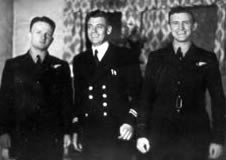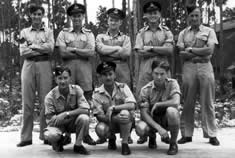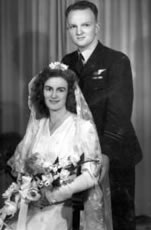
 |
War years - 'Conjunction of the highest pleasure with the other job'
Tom recounts how he met Gough Whitlam at the embarkation depot in Bradfield Park. |
|||||||||||||||||||||||||||||
 |
1943 saw Tom Fitzgerald in North America to train under the Empire Air Training Scheme JJohn Curtin Prime Ministerial Library. Records of the
Fitzgerald family. Tom Fitzgerald, Lt Norman Beaver (R.A.N.), Cam (Cyril)
McCall; Chicago c. Sept 1943. JCPML00720/76 |
||||||||||||||||||||||||||||
Tom Fitzgerald was chosen to go to Canada under the Empire Air Training Scheme - a streaming he considered 'personally lucky, but nationally regrettable'.
Tom and his friends featured in a Chicago Sunday Times article of 10 October 1943 with the unlikely caption Tickety Boo! Tom sent a cutting with his next letter to his sister Tess and exhorted her 'to treasure it carefully as the one occasion in my life when I was dubbed handsome'! |
|||||||||||||||||||||||||||||
|
Tickety Boo! |
||||||||||||||||||||||||||||
Tom opted to take his 'absolutely final training, which was the Operational Training Unit, OTU, in the Bahamas' on the promise that this would get him 'into operations more quickly'.
|
|||||||||||||||||||||||||||||
 |
Tom Fitzgerald, centre back row, on final training in the Bahamas. John Curtin Prime Ministerial Library. Records
of the Fitzgerald family. Tom Fitzgerald in the Bahamas, 1940s. JCPML00720/69 |
||||||||||||||||||||||||||||
For Tom Fitzgerald, the war was a mixture of best and worst - a wonderful world trip taking place against a backdrop of war - a 'conjunction of the highest pleasure with the other job'. |
|||||||||||||||||||||||||||||
 |
Tom and Margaret Fitzgerald on their wedding day, November 1945 John Curtin Prime Ministerial Library. Records of the Fitzgerald family. Tom and Margaret Fitzgerald, wedding portrait, November 1945. JCPML00720/83 |
||||||||||||||||||||||||||||
Footnotes1 - 4. John Curtin Prime Ministerial Library. Records of the National Library of Australia. Interview of Tom Fitzgerald, 01/02/1988 - 3/09/1988. JCPML00658/1. Original held by National Library of Australia TRC 2247 |
|||||||||||||||||||||||||||||